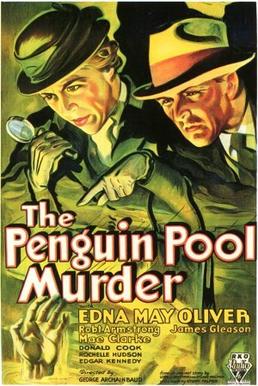
Scarlet Street is a 1945 American film noir directed by Fritz Lang. The screenplay concerns two criminals who take advantage of a middle-aged painter in order to steal his artwork. The film is based on the French novel La Chienne by Georges de La Fouchardière, which had been previously dramatized on stage by André Mouëzy-Éon, and cinematically as La Chienne (1931) by director Jean Renoir.

Legally Blonde is a 2001 American romantic comedy film directed by Robert Luketic and written by Karen McCullah Lutz and Kirsten Smith, based on Amanda Brown's 2001 novel of the same name. It stars Reese Witherspoon, Luke Wilson, Selma Blair, Matthew Davis, Victor Garber, and Jennifer Coolidge. The story follows Elle Woods (Witherspoon), a sorority girl who attempts to win back her ex-boyfriend Warner Huntington III (Davis) by getting a Juris Doctor degree at Harvard Law School, and in the process, overcomes stereotypes against blondes and triumphs as a successful lawyer.
Witness to Murder is a 1954 American film noir crime drama directed by Roy Rowland and starring Barbara Stanwyck, George Sanders, and Gary Merrill. While the film received moderately positive reviews, it ended up as an also-ran to Alfred Hitchcock's somewhat similar Rear Window, which opened less than a month later. The latter picture was a box-office hit.

Blue Steel is a 1990 American action thriller film directed by Kathryn Bigelow and starring Jamie Lee Curtis, Ron Silver and Clancy Brown. The film is about a police officer who shoots and kills a robbery suspect on her first day of duty and then becomes involved with a witness of the shooting.

The Saint Takes Over, released in 1940 by RKO Pictures, was the fifth of eight films in RKO's film series about Simon Templar, also known as "The Saint", the Robin Hood-inspired crimefighter created by Leslie Charteris. George Sanders played Templar for the fourth time. Sanders made one more Saint picture the following year. Wendy Barrie played his latest romantic interest, in her second of three appearances in the Saint film series.

Dorothy Revier was an American actress.

Night World is a 1932 American pre-Code drama film featuring Lew Ayres, Mae Clarke, and Boris Karloff. The supporting cast includes George Raft and Hedda Hopper.

Sheila Terry was an American film actress.

Chasing the Dime is a 2002 novel by American crime-writer Michael Connelly. It is his twelfth novel overall, and the only one to feature protagonist Henry Pierce.

Edna Murphy was an American actress of the silent era. She appeared in 80 films between 1918 and 1933. Murphy was voted "Most Photographed Movie Star of 1925" by ScreenLand Magazine.

The Penguin Pool Murder is a 1932 American pre-Code comedy/mystery film starring Edna May Oliver as Hildegarde Withers, a witness in a murder case at the New York Aquarium, with James Gleason as the police inspector in charge of the case, who investigates with her unwanted help, and Robert Armstrong as an attorney representing Mae Clarke, the wife of the victim. Oliver's appearance was the first film appearance of the character of Hildegarde Withers, the schoolteacher and sleuth based on the character from the 1931 novel The Penguin Pool Murder by Stuart Palmer. It is the first in a trilogy including Murder on the Blackboard, and Murder on a Honeymoon, in which Oliver and Gleason team up for the lead roles.

Smithereens is a 1982 American drama film directed by Susan Seidelman and starring Susan Berman, Brad Rijn, and Richard Hell. The film follows a narcissistic, young woman from New Jersey who comes to New York City to join the waning punk subculture, only to find that she's gravitated towards Los Angeles; in order to pay her way across country, she engages in a number of parasitic relationships, shifting her allegiances to new "friends" in an ongoing effort to ultimately endear herself to someone who will finance her desired lifestyle.

Behind Green Lights is a 1946 American crime film directed by Otto Brower and starring Carole Landis, William Gargan and Mary Anderson. It was produced and distributed by Twentieth Century Fox.

The Falcon Takes Over, is a 1942 black-and-white mystery film directed by Irving Reis. The B film was the third, following The Gay Falcon and A Date with the Falcon (1941), to star George Sanders as the character Gay Lawrence, a gentleman detective known by the sobriquet the Falcon.

Smart Blonde is a 1937 American mystery film directed by Frank McDonald. Starring Glenda Farrell as Torchy Blane, a fast-talking wisecracking female reporter, teaming up with her boyfriend detective Steve McBride, to solve the killing of an investor who just bought a popular local nightclub.

Shield for Murder is a 1954 American film noir crime film co-directed by and starring Edmond O'Brien as a police detective who has become malevolent. It was based on the novel of the same name by William P. McGivern.

Club Havana is a 1945 American film drama directed by Edgar G. Ulmer. It was produced and released by independent film company Producers Releasing Corporation. It has been compared to the 1933 film Grand Hotel.

Nothing Underneath is a 1985 Italian thriller film directed by Carlo Vanzina. The film is about Bob Crane who has visions of his fashion model twin sister being murdered in Milan, but finds his sister has disappeared on his arrival in Italy.

A Man's Neck is a 1933 French crime film directed by Julien Duvivier and starring Harry Baur, Valéry Inkijinoff, Gaston Jacquet and Gina Manès.It is an adaptation of the 1931 novel A Battle of Nerves by Georges Simenon, featuring the fictional detective Jules Maigret. It was the third film in cinema history to feature the Maigret character. It was remade in 1950 as The Man on the Eiffel Tower.

The Siren is a lost 1927 American silent melodrama film directed by Byron Haskin. It stars Tom Moore, Dorothy Revier, and Norman Trevor, and was released on December 20, 1927.



















